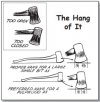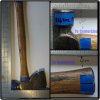Hickory n steel
Gold Member
- Joined
- Feb 11, 2016
- Messages
- 20,577
Yes, link at least tends to use decent wood.Better too fat than too thin. You can take wood off with very little effort and it gives you more leeway in how you choose to tune it up.
The grain orientation is often bad but that doesn't matter as much in a single handed swinging tool.
Now the scout style fawns foot hatchet handles my hardware store gets are always terrible.
One time I got a really good one, but otherwise whenever I look the ends are way too skinny like somebody took a belt sander to the swell and fawns foot.







